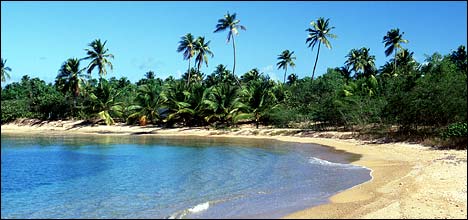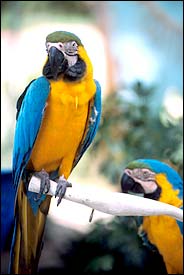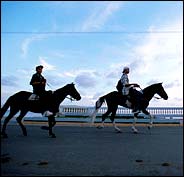|
 |
|
Esta página no está disponible en español. THE NEW YORK TIMES FRUGAL TRAVELER A Quiet Isle With Occasional Rumblings By DAISANN McLANE March 9, 2003
Green Beach, on the west end of Vieques, Puerto Rico. Photo: Associated Press ---------- FRUGAL traveling doesn't get much better than this: a deserted Caribbean beach, and back roads that wind through forests where wild horses run free and egrets glide above the mangroves edging the water. I thought of friends shivering in January weather in New York as I tooled lazily around a sunny island in a rented Jeep, dodging careless dogs and dawdling bulls, stopping for a great meal before returning to a breezy guest house with a view straight out to sea. I did more than think about my friends; I called several, begging them to join me in this paradise with a price tag of around $135 a day, including car, lodging and meals. I'd planned to stay six nights; that stretched into 10. How did I manage to find such a sweet deal in the Caribbean in high season? The answer, or at least part of it, loomed on the distant horizon, a familiar silhouette of battleship gray: a Navy warship. This paradise, Vieques, Puerto Rico, is known more for the controversy surrounding it than for its beaches or restaurants. Since 1947, the 21-by-4-mile island just off the east coast of Puerto Rico has been used by the United States Navy as a training site and bombing range, and Navy bases once took up about two-thirds of Vieques. But the protests against Navy bombing began to surge in 1999, after a local man was killed by a stray bomb, and the Navy has been phasing out its presence. ---------- Esperanza residents. Photo: Associated Press ---------- The base at the western end of the island (home to the wild horses and the deserted beach, called Green Beach) was returned to the Puerto Rican government in 2001; by May 1 of this year, the Navy has pledged to return Camp Garcia, the largest base, which covers about half of the island, to Puerto Rico. It will remain undeveloped, as a nature preserve. I wasn't sure what I'd find in Vieques, but local online newsletters and community Web sites were encouraging - the island is one of the few places left in the Caribbean where you can find a guest house in high season for around $50 a night. I telephoned one, Posada Vistamar, and booked a room. I then called Maritza's Car Rental and reserved a Jeep, also for $50 a day. Finally, I called Vieques Air Link and booked a round-trip ticket from San Juan for around $110. The trip was a gamble, but I hit the trifecta. Posada Vistamar is in Esperanza, the island's second largest town, after Isabel Segunda. The guest house, a concrete, motel-like block of six rooms, faces a little yard with trees, tables and chairs. Pretty basic was my first thought, but clean and comfortable enough; it had a bathroom with shower, an air-conditioner and a ceiling fan. Settling in, I put away my stuff, then wandered out to see Esperanza. A tiny settlement that fronts the ocean, it is centered on a commercial strip - mostly restaurants - that's about a 10-minute walk from end to end. Along part of the strip, there's a concrete promenade, the Malecón, for strolling. I ambled along, noticing that the other strollers seemed to be equally divided between local Puerto Ricans and sun-leathered gringos. At sunset I stopped at Banana's, one of the strip's open-air bar-restaurants, for a rum punch. There I met snowbirds from Canada and New England who told me they've been coming to Vieques for years and years. I met a retired man from Connecticut who recently bought a house on the island, and who told me that there was a sizable community of younger retirees, lured by the reasonable real estate prices and laid-back, undeveloped atmosphere. After a while, I strolled back to the Posada Vistamar for a delicious dinner that riffed elegantly on Latin Caribbean cuisine - tostones (fried green plantains) topped with cream and caviar, and a whole fish stewed in pepper sauce. Everything was perfect, or nearly so, and when I crawled into bed I was looking forward to sleep followed by a lazy morning, perhaps coffee along the Malecón. But around midnight I was awakened by an irritable stinging sensation along the side of my neck. As I turned on the light, I could hear the buzz of diligent mosquitoes. Despite the ceiling fan, despite the chugging air-conditioner, despite the window screens, they had zeroed in on their target, and there was no escape for the rest of the night.
Riding along Malecón in Esperanza. Photo: Associated Press ---------- The next morning, realizing that the seaside lowlands of Esperanza might not be the best location for someone allergic to mosquito bites, I headed out to find another place to stay. Driving in the hills, I spotted a sign for La Finca Caribe, a guest house I'd noticed on a Web site, but had not phoned because the listed rates seemed too high. I took a chance and drove up the road leading to a huge, airy, two-story wooden house painted in tropical blues and greens. There was a woman who looked familiar - my waitress the night before. Like many Americans transplanted to the island, Rebecca Wheaton, La Finca's co-manager, juggles several jobs (she's also a massage therapist, and her boyfriend, Seth, is La Finca's co-manager and the chef at Posada Vistamar). When I asked her about a room, she got enthusiastic - things have been slow at La Finca, and on Vieques in general. La Finca, in fact, was in the process of being sold. It was built as a women's retreat in the early 1990's, then was sold to some dot-commers from Seattle in 1997, who turned it into a commercial guest house and now want to sell. By now I have a sixth sense for hotels, and La Finca was pushing all the right buttons, with its large, breezy wooden deck and lovely, rolling property studded with palm trees and hibiscus. A big communal kitchen dominated the ground floor, which was filled with funky old furniture and walls of heavily thumbed paperbacks. When Ms. Wheaton offered me a room for $50 a night, I said yes without hesitation. (Regular rates are $50 to $70.) The bathroom was down the hall, and the shower was about 200 feet away, in separate stalls outside the building, which at first gave me pause. But I grew to love taking a shower in the neat, roofless wooden stall, under the sun and stars (and after a few days on the sandy beaches, I understood the logic of showering far from the bedrooms). Just outside my bedroom, which had a double bed with a mosquito net and a single loft bed, an upper wooden deck offered a view clear out to Esperanza, about two and a half miles away, and the ocean. There was a hammock on that deck, and for the next several days I spent most of my time there, swaying in the sun and reading Gabriel Garcia Márquez's memoirs, "Vivir Para Contarla," which I'd bought at the San Juan airport. I read Spanish more slowly than English, but in Vieques I wound down to the point where half-speed seemed perfect. And so it was especially alarming when early one morning I awakened to a series of loud explosions: "BOOM! BOOM! BOOM!" Running to the deck, I spotted a warship far out at sea, and noticed two fighter jets zooming through the sky in tight formation. At a bodega in Esperanza later that morning, I picked up a copy of El Nuevo Día. The booms, based on what I read, were probably from Navy ships far out at sea. These were to be the last weeks of maneuvers. Because the aircraft carrier Theodore Roosevelt was soon moving to the Middle East, the article speculated these maneuvers might be the last ones in Vieques before the planned Navy pullout May 1. The explosions ended with as little warning as they had begun with. Exploring Vieques, from the small seaside town of Isabel Segunda, where the ferry from Fajardo on Puerto Rico pulls in, to the deserted Navy base on the west coast, where storage huts have been overrun by cattle and beautiful wild horses, it was easy to forget about the Navy, until one stopped to think about why such a beautiful, accessible Caribbean island still looked like a rural backwater. Once I'd adjusted to the heat and the slow pace, I began leaving my aerie at La Finca more often, assigning myself the serious task of choosing my favorite among the island's many restaurants. The winners: La Sirena, a classic French bistro in Esperanza run by François Feynerol, who used to own Dix et Sept in Greenwich Village; Posada Vistamar, where you'd never know the Caribbean cuisine was being cooked by a Bostonian; and Taverna Española, a cheap and cheerful homestyle seafood place in Isabel Segunda. One evening I signed up to paddle a kayak through Vieques's natural wonder, the Bioluminescent Bay. The narrow-necked bay is home to a concentrated population of a microorganism that glows in the dark when disturbed; every dip of the paddle, every startled stingray illuminates a neon trail. As I jumped into the warm water in the darkness, my body was surrounded by an eerie glow, my cupped hands filled with miniature sparkles. Another day I went scuba diving. I didn't expect reefs so close to the populous mainland, and within shouting distance of a testing range, to be especially lush, and they weren't, but I did see barracudas, enormous lobsters, fan corals and thousands of tiny iridescent fish. I saw most of the same corals and fish simply snorkeling offshore at Green Beach, the string of sandy coves where I returned, day after day, to the same deserted crescent of sand (but only between 10 a.m. and 2 p.m., while the sand flies took their break). From my spot on Green Beach, at 10:30 every morning, I watched a gray warship slowly cross the horizon, heading toward Puerto Rico. The Navy has said that its exercises in early February would be the last regularly scheduled shellings of the island, so I may have been witnessing the end of an era in Vieques. And I wondered if its future would look like the sight I passed daily on my way to Isabel Segunda, east of the entrance to Green Beach: a gated property of compact cottages spread along a seaside rise, like so many elsewhere in the Caribbean. This 156-room resort, called Martineau Bay, had been under construction for several years, and on Feb. 24, it opened as part of the Wyndham chain. It is Vieques's first luxury resort, with room prices topping $300 a night. Changes, certainly, were coming to Vieques. Visitor Information I spent $134 a day for 10 days on Vieques, covering food, hotel, Jeep rental and activities like diving and nature tours. Transportation My round-trip ticket from Kennedy to San Juan on American Airlines cost $338.49. Vieques Air Link, (888) 901-9247, www.vieques-island.com/val, runs small single-prop planes from San Juan to Vieques. The trip, 30 minutes each way, costs $135 round trip. A Jeep Wrangler from Maritza's Car Rental, (787) 741-0078, Web site www.islavieques.com/maritzas.html, cost $50 a day, with tax. Filling the tank several times cost $40 total. Lodging My basic but clean room at Posada Vistamar, a guest house one block from Esperanza's promenade, the Malecón, (787) 741-8716, had a private bath with shower. It cost $55 with tax. Next time I would take a mosquito net; after sunset, the bugs can be nasty in Esperanza. La Finca Caribe, in the hilly center of the island about 2.5 miles from Esperanza, (787) 741-0495, online at www.lafinca.com, consists of a large two-story house with six guest rooms and two smaller cottages, one that sleeps up to five. It was built with large, friendly groups in mind - there's a well-equipped communal kitchen, a large wraparound deck and a pool. Showers are in a separate area down the hill, and two bathrooms - one upstairs and another downstairs - are shared by the six guest rooms. My room had a double and a single bed (the single was in a loft) with an electric fan that I never needed. The rate, with tax, was $55. The owners are talking with a few potential buyers. Dining La Sirena, facing the beach in Esperanza, (787) 741-4462, is a pretty, airy waterfront French-Caribbean restaurant. A typical dinner of avocado-yogurt cold soup, whole red snapper cooked in a sweet-sour sauce, and a perfect crème brûlée cost $33, including a glass of excellent Spanish red wine. I also enjoyed my Latin Caribbean meals at Posada Vistamar, in the same complex as the guest house. The chef turns out elegant interpretations of Puerto Rican staples. A meal of sautéed octopus, followed by pan-fried steak with garlic, cost around $30, including two glasses of red wine and dessert. In Isabel Segunda, about two miles from La Finca Caribe, I found two excellent restaurants. Café Media Luna, 351 A. G. Mellado, (787) 741-2594, in a pretty yellow two-story colonial house, is run by a former New Yorker of Puerto Rican descent and his Bombay-born wife, who has created the menu, a fusion of Latin and South Asian cuisines. A dinner of several courses (presented tapas style), plus two glasses of wine and coffee, came to around $50. Also in Isabel Segunda, Taverna Española, an unpretentious place on Carlos Lebron one block from the town square, (787) 741-1175, serves dishes like shrimps in garlic and olive oil, and fried chorizo, with generous sides of rice and beans. Dinner was $14.50 with a glass of wine. In Esperanza, a well-provisioned deli, Chef Michael's, 134 Calle Flamboyan, (787) 741-0490, sells freshly sliced Serrano ham and good cheeses for alfresco lunches. Activities Blue Caribe Dive Center, (787) 741-2522, a PADI-certified shop in Esperanza, is the only dive shop on the island. A two-tank dive plus equipment rental was $90; the company runs a nighttime kayak tour to the Bioluminescent Bay for $23. Island Adventures, (787) 741-0720, runs nightly excursions to the bay from just west of Esperanza on a pontoon boat for $23. I took a group yoga class with Jennifer Dehner, (787) 741-4453, at Hix Island House guest house in Pilón; she charges $15 for 1 hour 45 minutes.
|

 ----------
----------
 ----------
----------